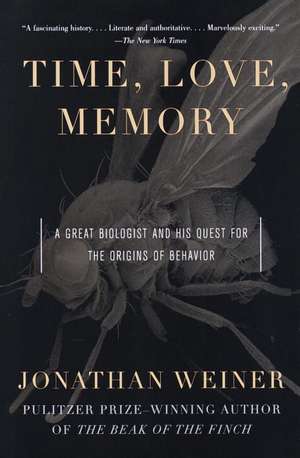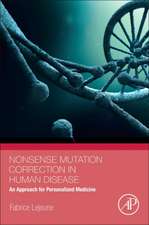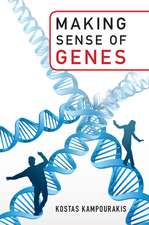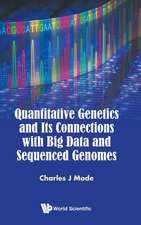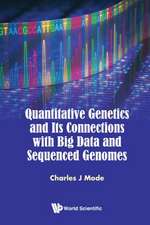Time, Love, Memory: A Great Biologist and His Quest for the Origins of Behavior
Autor Jonathan Weineren Limba Engleză Paperback – 31 mar 2000
Jonathan Weiner, winner of the Pulitzer Prize for The Beak of the Finch, brings his brilliant reporting skills to the story of Seymour Benzer, the Brooklyn-born maverick scientist whose study of genetics and experiments with fruit fly genes has helped revolutionize or knowledge of the connections between DNA and behavior both animal and human.
How much of our fate is decided before we are born? Which of our characteristics is inscribed in our DNA? Weiner brings us into Benzer's Fly Rooms at the California Institute of Technology, where Benzer, and his asssociates are in the process of finding answers, often astonishing ones, to these questions. Part biography, part thrilling scientific detective story, Time, Love, Memory forcefully demonstrates how Benzer's studies are changing our world view--and even our lives.
Preț: 111.01 lei
Nou
Puncte Express: 167
Preț estimativ în valută:
21.24€ • 22.24$ • 17.58£
21.24€ • 22.24$ • 17.58£
Carte disponibilă
Livrare economică 17-31 martie
Preluare comenzi: 021 569.72.76
Specificații
ISBN-13: 9780679763901
ISBN-10: 0679763902
Pagini: 320
Ilustrații: 50 PHOTOGRAPHS
Dimensiuni: 131 x 204 x 17 mm
Greutate: 0.33 kg
Ediția:Vintage Books
Editura: VINTAGE BOOKS
ISBN-10: 0679763902
Pagini: 320
Ilustrații: 50 PHOTOGRAPHS
Dimensiuni: 131 x 204 x 17 mm
Greutate: 0.33 kg
Ediția:Vintage Books
Editura: VINTAGE BOOKS
Notă biografică
Jonathan Weiner lives in Bucks County, PA.
Extras
Seymour Benzer's Laboratory runs along two corridors of Church Hall at the California Institute of Technology in Pasadena. His private workroom is at the corner where the corridors meet. Here he keeps his own tools and trophies, and an owl's hours. It is a windowless room lined with plastic bins that Benzer labeled decades ago in his spidery black script: Lenses, Mirrors, Needles, Wires, Pencils, Switches, Toothpicks, Pipe Cleaners, anything and everything he might need for an experiment in the middle of the night, including Teeth (Human and Shark).
The old gray benchtop is all test tubes and bottles: mostly standard-issue laboratory stock, but here and there a half-pint milk bottle with heavy scratched glass and antique advertising ("5 cents--Just a Little Better") stoppered with a foam-rubber cork. These tubes and bottles hold a sampling of the thousands of mutants that Benzer and his students, his students' students, and his competitors have engineered.
The mutants are fruit flies, and their mutations have changed their
behavior. One of them is timeless, a clock mutant. In a windowless room like this one, the fly seems to wake and sleep at random intervals, as if it has broken its covenant with day and night, so that day and night will not come at their appointed time. Another is dissatisfaction, a female mutant that does not like males and keeps flicking them away with her wings. Then there is pirouette, which moves at first in big arcs, then in smaller and smaller arcs, like certain problems in science, turning at last on a single point, until it sometimes starves to death.
In the seventeenth century, the French philosopher Blaise Pascal looked up at the night sky and then looked down at a mite, picturing "legs with joints, veins in its legs, blood in the veins, humors in the blood, drops in the humors, vapors in the drops," and onward and downward to the atoms. "The eternal silence of these infinite spaces fills me with dread," he wrote. He meant two infinite spaces, which he called the two infinites of science, one above and around him, the other below and inside him. Of the two infinites, the space that frightened him more was the space that he could not begin to see, the stardust of atoms that made up his very thoughts and fears and moved the fingers around his pen. "Anyone who considers himself in this way will be terrified at himself."
The twentieth century was a long spiral inward on Pascal's path, beginning with a single mutant fly in a milk bottle in the century's first years, and reaching the atoms that Pascal dreaded to see near the century's close. If the spiral leads where it now promises or threatens to lead, this may be remembered as one of the most significant series of discoveries since science began, matching or surpassing the discoveries of twentieth-century physics. In the universe above and around us, physics opened new views of space and time; in the universe below and inside us, biology opened first glimpses of the foundation stones of experience: time, love, and memory.
What are the connections, the physical connections, between genes and behavior? What is the chain of reactions that leads from a single gene to a bark, or a laugh, or a song, or a thought, or a memory, or a glimpse of red, or a turn toward a light, or a raised hand, or a raised wing? The first scientists to look seriously at this question were the revolutionaries who figured out what genes are made of atom by atom--the founders of the science now known as molecular biology. Seymour Benzer was one of those revolutionaries, and he and his students took the enterprise farthest. Benzer's work on the problem was quiet, his students' work was quiet, and their story has never been told. But to a large extent the hard science of genes and behavior came out of their fly bottles. In this sense the fly bottle is one of the most significant legacies that the science of the twentieth century bequeaths to the twenty-first, a time, love, memory great gift and disturbance that human knowledge conveys to the night thoughts and day-to-day life of the third millennium. Pascal quoted Saint Augustine: "The way in which minds are attached to bodies is beyond our understanding, and yet this is what we are."
From a shelf in his workroom, Benzer takes down a dusty set of test tubes. They are bound together in such a way that he can slide one test tube mouth to mouth with another test tube, like one cup lidding another, to form a series of sealed glass tunnels. They look something like panpipes. The design is so simple that the first model he built back in the 1960s still works. Now the London Science Museum has a replica, and someone from the San Francisco Exploratorium wants to automate one so that it will cycle through its paces over and over inside a glass display case.
Benzer dusts off the test tubes and lays them down flat on the benchtop before him. Then he lays a dim fluorescent bulb of fifteen watts on the far side of the benchtop. When he switches off the overhead lights, the fluorescent bulb glints on the test tubes and gleams on his reading glasses. The rows of bottles and bins, the stacks of books and manuscripts drop halfway into shadow. The light just catches the outlines of an ammonite propped against the far wall; a fossil shell the shape of a coiled elephant's trunk; and a row of trilobites, stone fossils with bulbous eyes. In the far corner of the sanctum a human brain sits in the dark. Benzer keeps meaning to find a proper jar for the brain. He wants to put it on his desk as a memento mori or a memento vivere ("Remember to live"). The brain waits in a bucket of formaldehyde, and what is left of its spinal cord curls in the bottom of the bucket like the lifeline of an embryo.
Benzer got the idea for his panpipes one night in 1966, when he put two test tubes mouth to mouth to make one long tube with a single fruit fly trapped inside it. He turned out the light; he rapped the tubes on his benchtop to make the fly drop to the bottom; and he laid the tubes flat on the benchtop with the fly at one end of the tunnel and a small dim light at the other. Sitting in the shadows, he watched the fly in the tunnel move toward the light, just as he had expected it to do, because according to the textbooks a grown fruit fly in a dark place is attracted to light--so is a grown human being in a similar situation. The next fly also moved toward the light. But he was surprised to see that when he put a single fly through this simple trial a few times in a row, the fly did not always do the same thing. One fly raced to the light once, walked to it the next time, and then quit. Another fly ignored the light the first time and then raced for it at the next opportunity. Most flies did choose the light most of the time, but each trial seemed unpredictable.
In 1966 it was already clear that however else historians would remember the twentieth century, they would remember it for the discovery of the atomic theory of matter and the atomic theory of inheritance. Physicists and geneticists had developed both theories early in the century. At midcentury a small circle of young scientists, including Benzer and Francis Crick (both lapsed physicists) and James Watson (a lapsed ornithologist) had united the two theories. They discovered what genes are made of atom by atom--the double helix, the spiral staircase of DNA; they mapped the fine structure of the gene down to the level of its atoms; and they cracked the code in which the genetic messages are written. They now knew precisely what a gene is physically, although they did not know how to connect the details they were looking at, which were atomic, with the details of the living world that most interested them and interest all of us: hands, eyes, lips, thoughts, acts, behavior. Within ten years the physicists-turned-biologists had learned so much about genes that they had begun to look around and above the genes for new worlds to conquer. To the boldest, many worlds beckoned, innumerable lines of work radiated outward from the gene, including the problems of the origin of life; the growing embryo; consciousness; and behavior, a problem that Crick called "attractively mysterious, one of the last true secrets in biology."
Watson, Crick, Benzer, and their circle had arrived at the double helix by working with viruses and E. coli bacteria in petri dishes. But they knew that geneticists before them had worked out the atomic theory of inheritance using fruit flies in milk bottles. Benzer has a strong, somewhat sentimental sense of history, and it appealed to him to make the next great leap forward by going back. Fruit flies are bigger than bacteria, but they are still tiny. They are grains of sand with wings, small enough to crawl through the mesh of screen doors, almost as small as Pascal's mites, so small that Aristotle mistook them for gnats. Coming from physics and from E. coli, Benzer saw them as atoms of behavior, and he thought they might be the perfect creatures with which to found a new science, an atomic theory of behavior.
By chance, the very first published laboratory study of Drosophila, or fruit flies, a long-forgotten paper that he tracked down some time afterward, had been a report on the flies' behavior: their reactions to light, gravity, and mechanical stimulation. Even that first report, which appeared in 1905, had suggested that the flies' instinct for light is not simple. If their jar was sitting on the windowsill--a biologist at Harvard reported--most of the flies would come to rest on the sides of the jar with their heads pointed away from the sun. But turn the jar slightly, and nearly every fly instantly flew toward the window.
To Benzer, Drosophila looked like just the happy medium he was looking for. An E. coli bacterium is a single cell. In a sense, he could think of it as a nervous system with a single neuron. At birth, a human baby has about one hundred billion neurons, one for every star in the Milky Way. A fruit fly has about one hundred thousand neurons, so it is the geometric mean between the simplest and the most complicated nervous system we know. Likewise, the mass of a single E. coli bacterium is one ten-trillionth of a gram. The mass of a man is one hundred thousand grams. The fly is roughly the geometric mean, at two thousandths of a gram. And a bacterium has a generation time of a hundredth of a day, while a human being has a generation time of ten thousand days (ten thousand days, to pick a generous round numbers, before one human being produces another). A fly has a generation time of about ten days, again roughly a geometric mean between the two. Even the number of genes in the fly is a mean between bacteria and human beings. In very round numbers a bacterium has 4,000 genes, a human being has 70,000 genes, and a fly has 15,000 genes, which puts it once again between the simplest and the most complicated creatures we know on the planet.
Benzer modeled his test-tube experiment after a laboratory routine that he had learned from a chemist. The chemist used a simple trick to separate two compounds that were mixed together. One of his compounds would dissolve slightly more easily in oil and the other more easily in water. So the chemist put his mixture in oil and water and shook it up. He let the oil and water separate, oil above and water below. Then he transferred the top layer to a new tube and the bottom layer to another tube. He added fresh oil and water and shook them up again. When he had done this enough times, he found that he had separated the two compounds. The tube of oil now had an almost pure sample of the compound that liked oil, the tube of water an almost pure sample of the compound that liked water. Chemists call this the countercurrent distribution method because in a sense it sets currents flowing in opposite directions: one compound flowing upward, the other flowing downward.
So Benzer decided to make his own countercurrent apparatus. He assumed that most of the flies in the world's fly bottles like the light somewhat more than the dark but that a few might like the dark somewhat more than the light. He wanted to let the flies sort themselves into two more or less pure sets of particles, the light-lovers and the dark-lovers. Then he would look for the genes that made the difference. After some trial and error he hit on the idea of the panpipes. By mounting a set of test tubes in such a way that they could slide against each other, he could carry out a series of simple sorting operations, just like the chemist's.
Sitting now in the half-dark of his sanctum, he uncorks one of his antique milk bottles ("Just a Little Better"), and he inserts a few dozen fruit flies into the tube on the far left of his countercurrent apparatus: Tube Zero. Then he raps the whole set of tubes on the benchtop a few times. In the quiet of his workroom in the middle of the night, the sound is like a pounding on the door. The raps knock the flies to the bottom of Tube Zero, and the flies swarm there a moment in the half-light, flailing as if in free fall. They are so small that they really do look like the Greek idea of atoms, points whirling in space, almost invisible and absolutely indivisible. (Atomos means "unsplittable.")
Benzer lays the countercurrent machine back down on the benchtop. The flies at the bottom of Tube Zero are now at one end of a glass tunnel. The only light they can see is the light at the far end of the tunnel, the fifteen-watt fluorescent tube. The flies can stay put in the bottom of Tube Zero, or they can move toward the light. As Pascal says, "There is enough light for those who desire only to see, and enough darkness for those of a contrary disposition." So the flies are facing a simple choice. If they do not move forward, they will remain in Tube Zero. If they do move forward, they will find themselves in the next test tube, Tube One.
Some of the flies walk, some of them run, some of them fly, and some of them meander. By the time fifteen seconds have passed, all but two of the flies have gone toward the light.
Benzer picks up the apparatus and slides the test tubes around. Now the flies that went toward the light--almost all of the winged atoms in the machine--are in Tube One, while the two flies that did not go remain in Tube Zero.
"Everybody gets another chance," Benzer murmurs. Again he raps the apparatus on the benchtop. Again he lays it flat on the benchtop. Within fifteen seconds, most of the flies again go toward the light. But this time one of the flies in Tube Zero decides to go too, and a few of the flies that went the first time choose not to go.
"What are they doing now?" Benzer says. "They're wandering around." This is why he built the countercurrent machine in the first place. Facing the same choice point, the flies do not always make the same choice. As a swarm, as a mass, they are predictable, but as individuals they are unpredictable. Even fruit flies in a test tube do not always act the same way twice. Why not? Watching their decisions and revisions by the light of the fifteen-watt bulb back in 1966, Benzer got an inkling that flies might be more than atoms of behavior. He had thought they would be simple, regular, predictable, like the particles in the chemist's test tubes. Instead the flies act as if they are improvising from moment to moment, based on what each fly sees in front of it, what has happened in its past, and what can only be called the personality of that fly.
"Flip it over, switch it back." Now the flies that have chosen the light twice are in Tube Two. The flies that have chosen the light once are in Tube One. The fly that has never chosen the light is still in Tube Zero, moving erratically in the half-dark: To human eyes it looks like a troubled fly.
"Now we'll give them another chance." Benzer rocks and slides his gadget: the same operation, the same fifteen-second wait. Then again and again: knock, knock, knock. Each time, most of the flies move toward the light.
"OK, there we are," Benzer says at last, switching on the overhead lights. He can read the results at a glance. Tube Six contains flies that moved to the light six out of six times. Most of them are in there. Tube Five contains flies that moved five out of six times. And so on, all the way down to Tube Zero, the home of the troubled fly, which may be damaged goods.
To prove that he is really testing what he thinks he is testing, Benzer dumps all of the flies back into Tube Zero and sets the apparatus on the benchtop again. This time he sets it down with the flies next to the light. Now the flies face the opposite choice. They are near the light. They can choose to stay where they are, or they can move away. When Benzer runs the experiment this way, most of the flies stay put in the bottom of Tube Zero. They do not hurry into the darkness the way they hurried into the light. Running the experiment backward this way is Benzer's control. It proves that in the first rounds the flies were not indifferent to the light; they were not advancing through the tubes just for the sake of advancing through the tubes. He is looking at what he thinks he is looking at. The light is the key.
Philosophers used to speak of the ultimities. The last stop of a trip, the highest high C of a musical scale, and the final stage of an alchemical process, when the liquid in a beaker had traveled "from Crudity to Perfect Concoction," as Sir Francis Bacon put it--these were ultimities.
In science, the ultimities are the ultimate questions. These are the questions that so many generations have raised that they have come to seem eternal, always to be asked and never to be answered. They are the problems that interest us so much that solving them--finding even a small piece of them--would feel like finding the secret of life. The origin of species was once one of the ultimities of science, until Darwin. The origin of the universe is one of the ultimities today. So is the origin of life. And the most intimate, the most immediate, in some ways the most intricate and the most important for our inquiring species, will always be the origin of behavior. We have asked these questions from the beginning: How much of our fate is decided before we are born? What is written and in what code and of what materials? What are the connections between atoms, thoughts, feelings, behavior? How much of our behavior is passed down with the genes from one generation to the next?
Benzer's countercurrent machine was a point of origin for the science of genes and behavior, a point of origin for the headlines that have punctuated the news for the last ten years and sometimes seem likely to dominate it within another ten years. It was the beginning of what Benzer calls the genetic dissection of behavior.
This is a science that is dedicated to exploring the inward infinity that Pascal imagined and to reading the writing on John Locke's slate--for even Locke knew that the slate is not blank. He thought that our temperaments are at least partly innate: "Some men by unalterable frame of their constitution are stout, others timorous, some confident, others modest and tractable." He did not think that much else about our minds is innate, although other eighteenth-century philosophers argued that we are born knowing a great deal: "that sweetness is not bitterness," to give one of the examples that Locke cited; or "that 'two bodies cannot be in the same place,' and that 'it is impossible for the same thing to be and not to be,' that 'white is not black,' that a 'square is not a circle,' that 'yellowness is not sweetness.' " Many philosophers assumed that "these and a million of other such propositions," as Locke skeptically wrote, "must be innate." Today, these are questions that the science of genes and behavior can begin to test at the level of the hipbone-is-connected-to-the-thighbone.
Sigmund Freud tried to make a solid science of human behavior. "Have you not noticed," he wrote early in the century, "that every philosopher, every imaginative writer, every historian and every biographer makes up his own psychology for himself, brings forward his own particular hypotheses concerning the interconnections and aims of mental acts--all more or less plausible and all equally untrustworthy? There is an evident lack of any common foundation." Freud tried to establish a foundation as solid as the foundations in physics and chemistry; but today the most interesting effort in progress is founded on physics, chemistry, and Benzer's beginning.
The new effort also builds on Darwin, and on the Darwinian studies of behavior that were attempted in the 1930s and 1940s by Konrad Lorenz, Niko Tinbergen, Karl von Frisch, and their students, who called themselves ethologists. One of Tinbergen's books is illustrated by the silhouette of a bird in flight. When newborn goslings see that silhouette in the sky, they read the shape as a goose if it is moving to the right, a hawk if it is moving to the left. The silhouette of the goose does not scare goslings, but the silhouette of the hawk sends them scurrying. That kind of hard fact fascinated the ethologists. Goslings don't learn to make that distinction between friend and enemy from their mothers. They know it from the first moment they see the sky. They know it when they are still standing in the nest with caps of eggshell on their heads. How do they know? Ethologists looked at such pieces of behavior and tried to dissect them into routines and subroutines, which they called "atoms of behavior." Now with the tools of genetic dissection biologists can actually begin to study the instincts of goslings and newborn babies at the level of the atoms.
In the 1970s, E. O. Wilson, inspired in part by his studies of ant societies, tried to extend the work of the ethologists to human beings in a new synthesis he called "sociobiology." Wilson was attacked by social scientists, on the one side, because they hated his attempt to biologize human nature, and he was attacked by biologists, on the other side, because they felt he had built castles in the air and had not acknowledged the need for hard molecular biologists to put foundations under them. Today many of those sociobiological speculations can be explored in the code of the ants, the code of the flies, and the code of human beings; and Wilson himself wants to claim the genetic dissection of behavior as a cornerstone of his foundation. "Better Benzer than Freud! Quote me. Better Benzer than Freud!" Wilson says, standing in his office by one of his celebrated colonies of leaf-cutter ants, to which he feeds Drosophila--preferably wingless mutants.
Philosophers used to speak of the ultimities. The last stop of a trip, the highest high C of a musical scale, and the final stage of an alchemical process, when the liquid in a beaker had traveled "from Crudity to Perfect Concoction," as Sir Francis Bacon put it--these were ultimities.
In science, the ultimities are the ultimate questions. These are the
questions that so many generations have raised that they have come to seem eternal, always to be asked and never to be answered. They are the problems that interest us so much that solving them--finding even a small piece of them--would feel like finding the secret of life. The origin of species was once one of the ultimities of science, until Darwin. The origin of the universe is one of the ultimities today. So is the origin of life. And the most intimate, the most immediate, in some ways the most intricate and the most important for our inquiring species, will always be the origin of behavior. We have asked these questions from the beginning: How much of our fate is decided before we are born? What is written and in what code and of what materials? What are the connections between atoms, thoughts, feelings, behavior? How much of our behavior is passed down with the genes from one generation to the next?
Benzer's countercurrent machine was a point of origin for the science of genes and behavior, a point of origin for the headlines that have punctuated the news for the last ten years and sometimes seem likely to dominate it within another ten years. It was the beginning of what Benzer calls the genetic dissection of behavior.
This is a science that is dedicated to exploring the inward infinity that Pascal imagined and to reading the writing on John Locke's slate--for even Locke knew that the slate is not blank. He thought that our temperaments are at least partly innate: "Some men by unalterable frame of their constitution are stout, others timorous, some confident, others modest and tractable." He did not think that much else about our minds is innate, although other eighteenth-century philosophers argued that we are born knowing a great deal: "that sweetness is not bitterness," to give one of the examples that Locke cited; or "that 'two bodies cannot be in the same place,' and that 'it is impossible for the same thing to be and not to be,' that 'white is not black,' that a 'square is not a circle,' that 'yellowness is not sweetness.' " Many philosophers assumed that "these and a million of other such propositions," as Locke skeptically wrote, "must be innate." Today, these are questions that the science of genes and behavior can begin to test at the level of the hipbone-is-connected-to-the-thighbone.
Sigmund Freud tried to make a solid science of human behavior. "Have you not noticed," he wrote early in the century, "that every philosopher, every imaginative writer, every historian and every biographer makes up his own psychology for himself, brings forward his own particular hypotheses concerning the interconnections and aims of mental acts--all more or less plausible and all equally untrustworthy? There is an evident lack of any common foundation." Freud tried to establish a foundation as solid as the foundations in physics and chemistry; but today the most interesting effort in progress is founded on physics, chemistry, and Benzer's beginning.
The new effort also builds on Darwin, and on the Darwinian studies of behavior that were attempted in the 1930s and 1940s by Konrad Lorenz, Niko Tinbergen, Karl von Frisch, and their students, who called themselves ethologists. One of Tinbergen's books is illustrated by the silhouette of a bird in flight. When newborn goslings see that silhouette in the sky, they read the shape as a goose if it is moving to the right, a hawk if it is moving to the left. The silhouette of the goose does not scare goslings, but the silhouette of the hawk sends them scurrying. That kind of hard fact fascinated the ethologists. Goslings don't learn to make that distinction between friend and enemy from their mothers. They know it from the first moment they see the sky. They know it when they are still standing in the nest with caps of eggshell on their heads. How do they know? Ethologists looked at such pieces of behavior and tried to dissect them into routines and subroutines, which they called "atoms of behavior." Now with the tools of genetic dissection biologists can actually begin to study the instincts of goslings and newborn babies at the level of the atoms.
In the 1970s, E. O. Wilson, inspired in part by his studies of ant societies, tried to extend the work of the ethologists to human beings in a new synthesis he called "sociobiology." Wilson was attacked by social scientists, on the one side, because they hated his attempt to biologize human nature, and he was attacked by biologists, on the other side, because they felt he had built castles in the air and had not acknowledged the need for hard molecular biologists to put foundations under them. Today many of those sociobiological speculations can be explored in the code of the ants, the code of the flies, and the code of human beings; and Wilson himself wants to claim the genetic dissection of behavior as a cornerstone of his foundation. "Better Benzer than Freud! Quote me. Better Benzer than Freud!" Wilson says, standing in his office by one of his celebrated colonies of leaf-cutter ants, to which he feeds Drosophila--preferably wingless mutants.
"There is Grandeur in this view of life," Charles Darwin writes in the last lines of The Origin of Species. Darwin found grandeur in the thought that life, "having been originally breathed into a few forms or into one," has gone and is still going in so many astonishing directions; that life, "whilst this planet has gone cycling on according to the fixed law of gravity," has produced and is now producing so many astonishing species and varieties, from viruses and bacteria to grass, from oaks to peacocks, great apes, and great whales; that "from so simple a beginning endless forms most beautiful and most wonderful have been, and are being, evolved."
Of all the endless forms that have been and are being evolved on this planet, some of the most wonderful (if not the most beautiful) have emerged from the laboratories of Seymour Benzer and his school. The science they make possible is changing our view of life; and both the most passionate proponents and opponents of the science believe that in the twenty-first century it may change the conditions and prospects of life. Many compare this moment to the sudden acceleration of science itself in the seventeenth century, Pascal's century, or of atomic physics in the first half of the twentieth century. Others say the pace of biology today is unprecedented. "To compare the speed with which understanding is being deepened in the life sciences with what happened in physics in the 1920s is probably flattering to physics," the former editor of the journal Nature wrote not long ago in his farewell editorial, after several decades of watching the molecular revolution. "Can there ever have been a time when there have been so many people pushing at an open door?"
As the twentieth century ends, more and more of the best and brightest in science are being drawn to the effort. Molecular biology has made biology the royalty of science. James Watson has installed one of the science's golden boys--one of Benzer's best students' best students--next to his own office at Cold Spring Harbor Laboratory, New York, where Watson is the director. Sometimes late in the evening Watson wanders into the Fly Rooms and looks at the madding crowds in the tidy bottles. He has a nimbus of white hair, but he is still almost as gaunt and gangly as he was at the age of twenty-four, when he cleared a space on his desktop, slid together a few puzzle pieces of tin and cardboard, and saw the double helix. Now when he looks at the mutants in the Fly Rooms next to his office, he feels that he is looking at the beginning of the twentieth century and also the beginning of the twenty-first. This is where his science started, and this is where it is going. "And--I just find it very--" Watson says with a blue-eyed cosmic stare. "You know, just divorcing yourself from humans--just forgetting about us. That there are certain complicated behaviors that seem to be inherited. That's really--" He laughs through his teeth with what sounds like a snicker of glee, as he must have laughed four decades ago when he was talking with Crick about the physical structure of the gene. "You know," he says, and he snickers again, "that's the problem to solve."
In the study of the physical links between genes and behavior, many of the first answers and half answers came from flies: time, love, memory, as viewed through a compound eye. In one way, this is a parable of the strangeness of life: so much millennial science from such tiny and alien creatures. In another way, it is a parable of the unity of life, since not only flies and human beings but everything alive springs from even homelier materials: the same genes, the same atoms, the same clay, the same simple beginnings. In the first view, the whole world looks alien to us; in the second view, there is nothing on earth that is not familiar.
Knowing what he does now, Benzer would not dream of calling a fruit fly just an atom of behavior. His research has reached that penultimate stage during which he would rather work than eat or sleep. In the middle of the night, after putting his test tubes back on their shelf, he unhoods a microscope and examines the head of a fly. "About the size of the head of a pin," he says. "A hundred thousand angels on it. Dancing."
The old gray benchtop is all test tubes and bottles: mostly standard-issue laboratory stock, but here and there a half-pint milk bottle with heavy scratched glass and antique advertising ("5 cents--Just a Little Better") stoppered with a foam-rubber cork. These tubes and bottles hold a sampling of the thousands of mutants that Benzer and his students, his students' students, and his competitors have engineered.
The mutants are fruit flies, and their mutations have changed their
behavior. One of them is timeless, a clock mutant. In a windowless room like this one, the fly seems to wake and sleep at random intervals, as if it has broken its covenant with day and night, so that day and night will not come at their appointed time. Another is dissatisfaction, a female mutant that does not like males and keeps flicking them away with her wings. Then there is pirouette, which moves at first in big arcs, then in smaller and smaller arcs, like certain problems in science, turning at last on a single point, until it sometimes starves to death.
In the seventeenth century, the French philosopher Blaise Pascal looked up at the night sky and then looked down at a mite, picturing "legs with joints, veins in its legs, blood in the veins, humors in the blood, drops in the humors, vapors in the drops," and onward and downward to the atoms. "The eternal silence of these infinite spaces fills me with dread," he wrote. He meant two infinite spaces, which he called the two infinites of science, one above and around him, the other below and inside him. Of the two infinites, the space that frightened him more was the space that he could not begin to see, the stardust of atoms that made up his very thoughts and fears and moved the fingers around his pen. "Anyone who considers himself in this way will be terrified at himself."
The twentieth century was a long spiral inward on Pascal's path, beginning with a single mutant fly in a milk bottle in the century's first years, and reaching the atoms that Pascal dreaded to see near the century's close. If the spiral leads where it now promises or threatens to lead, this may be remembered as one of the most significant series of discoveries since science began, matching or surpassing the discoveries of twentieth-century physics. In the universe above and around us, physics opened new views of space and time; in the universe below and inside us, biology opened first glimpses of the foundation stones of experience: time, love, and memory.
What are the connections, the physical connections, between genes and behavior? What is the chain of reactions that leads from a single gene to a bark, or a laugh, or a song, or a thought, or a memory, or a glimpse of red, or a turn toward a light, or a raised hand, or a raised wing? The first scientists to look seriously at this question were the revolutionaries who figured out what genes are made of atom by atom--the founders of the science now known as molecular biology. Seymour Benzer was one of those revolutionaries, and he and his students took the enterprise farthest. Benzer's work on the problem was quiet, his students' work was quiet, and their story has never been told. But to a large extent the hard science of genes and behavior came out of their fly bottles. In this sense the fly bottle is one of the most significant legacies that the science of the twentieth century bequeaths to the twenty-first, a time, love, memory great gift and disturbance that human knowledge conveys to the night thoughts and day-to-day life of the third millennium. Pascal quoted Saint Augustine: "The way in which minds are attached to bodies is beyond our understanding, and yet this is what we are."
From a shelf in his workroom, Benzer takes down a dusty set of test tubes. They are bound together in such a way that he can slide one test tube mouth to mouth with another test tube, like one cup lidding another, to form a series of sealed glass tunnels. They look something like panpipes. The design is so simple that the first model he built back in the 1960s still works. Now the London Science Museum has a replica, and someone from the San Francisco Exploratorium wants to automate one so that it will cycle through its paces over and over inside a glass display case.
Benzer dusts off the test tubes and lays them down flat on the benchtop before him. Then he lays a dim fluorescent bulb of fifteen watts on the far side of the benchtop. When he switches off the overhead lights, the fluorescent bulb glints on the test tubes and gleams on his reading glasses. The rows of bottles and bins, the stacks of books and manuscripts drop halfway into shadow. The light just catches the outlines of an ammonite propped against the far wall; a fossil shell the shape of a coiled elephant's trunk; and a row of trilobites, stone fossils with bulbous eyes. In the far corner of the sanctum a human brain sits in the dark. Benzer keeps meaning to find a proper jar for the brain. He wants to put it on his desk as a memento mori or a memento vivere ("Remember to live"). The brain waits in a bucket of formaldehyde, and what is left of its spinal cord curls in the bottom of the bucket like the lifeline of an embryo.
Benzer got the idea for his panpipes one night in 1966, when he put two test tubes mouth to mouth to make one long tube with a single fruit fly trapped inside it. He turned out the light; he rapped the tubes on his benchtop to make the fly drop to the bottom; and he laid the tubes flat on the benchtop with the fly at one end of the tunnel and a small dim light at the other. Sitting in the shadows, he watched the fly in the tunnel move toward the light, just as he had expected it to do, because according to the textbooks a grown fruit fly in a dark place is attracted to light--so is a grown human being in a similar situation. The next fly also moved toward the light. But he was surprised to see that when he put a single fly through this simple trial a few times in a row, the fly did not always do the same thing. One fly raced to the light once, walked to it the next time, and then quit. Another fly ignored the light the first time and then raced for it at the next opportunity. Most flies did choose the light most of the time, but each trial seemed unpredictable.
In 1966 it was already clear that however else historians would remember the twentieth century, they would remember it for the discovery of the atomic theory of matter and the atomic theory of inheritance. Physicists and geneticists had developed both theories early in the century. At midcentury a small circle of young scientists, including Benzer and Francis Crick (both lapsed physicists) and James Watson (a lapsed ornithologist) had united the two theories. They discovered what genes are made of atom by atom--the double helix, the spiral staircase of DNA; they mapped the fine structure of the gene down to the level of its atoms; and they cracked the code in which the genetic messages are written. They now knew precisely what a gene is physically, although they did not know how to connect the details they were looking at, which were atomic, with the details of the living world that most interested them and interest all of us: hands, eyes, lips, thoughts, acts, behavior. Within ten years the physicists-turned-biologists had learned so much about genes that they had begun to look around and above the genes for new worlds to conquer. To the boldest, many worlds beckoned, innumerable lines of work radiated outward from the gene, including the problems of the origin of life; the growing embryo; consciousness; and behavior, a problem that Crick called "attractively mysterious, one of the last true secrets in biology."
Watson, Crick, Benzer, and their circle had arrived at the double helix by working with viruses and E. coli bacteria in petri dishes. But they knew that geneticists before them had worked out the atomic theory of inheritance using fruit flies in milk bottles. Benzer has a strong, somewhat sentimental sense of history, and it appealed to him to make the next great leap forward by going back. Fruit flies are bigger than bacteria, but they are still tiny. They are grains of sand with wings, small enough to crawl through the mesh of screen doors, almost as small as Pascal's mites, so small that Aristotle mistook them for gnats. Coming from physics and from E. coli, Benzer saw them as atoms of behavior, and he thought they might be the perfect creatures with which to found a new science, an atomic theory of behavior.
By chance, the very first published laboratory study of Drosophila, or fruit flies, a long-forgotten paper that he tracked down some time afterward, had been a report on the flies' behavior: their reactions to light, gravity, and mechanical stimulation. Even that first report, which appeared in 1905, had suggested that the flies' instinct for light is not simple. If their jar was sitting on the windowsill--a biologist at Harvard reported--most of the flies would come to rest on the sides of the jar with their heads pointed away from the sun. But turn the jar slightly, and nearly every fly instantly flew toward the window.
To Benzer, Drosophila looked like just the happy medium he was looking for. An E. coli bacterium is a single cell. In a sense, he could think of it as a nervous system with a single neuron. At birth, a human baby has about one hundred billion neurons, one for every star in the Milky Way. A fruit fly has about one hundred thousand neurons, so it is the geometric mean between the simplest and the most complicated nervous system we know. Likewise, the mass of a single E. coli bacterium is one ten-trillionth of a gram. The mass of a man is one hundred thousand grams. The fly is roughly the geometric mean, at two thousandths of a gram. And a bacterium has a generation time of a hundredth of a day, while a human being has a generation time of ten thousand days (ten thousand days, to pick a generous round numbers, before one human being produces another). A fly has a generation time of about ten days, again roughly a geometric mean between the two. Even the number of genes in the fly is a mean between bacteria and human beings. In very round numbers a bacterium has 4,000 genes, a human being has 70,000 genes, and a fly has 15,000 genes, which puts it once again between the simplest and the most complicated creatures we know on the planet.
Benzer modeled his test-tube experiment after a laboratory routine that he had learned from a chemist. The chemist used a simple trick to separate two compounds that were mixed together. One of his compounds would dissolve slightly more easily in oil and the other more easily in water. So the chemist put his mixture in oil and water and shook it up. He let the oil and water separate, oil above and water below. Then he transferred the top layer to a new tube and the bottom layer to another tube. He added fresh oil and water and shook them up again. When he had done this enough times, he found that he had separated the two compounds. The tube of oil now had an almost pure sample of the compound that liked oil, the tube of water an almost pure sample of the compound that liked water. Chemists call this the countercurrent distribution method because in a sense it sets currents flowing in opposite directions: one compound flowing upward, the other flowing downward.
So Benzer decided to make his own countercurrent apparatus. He assumed that most of the flies in the world's fly bottles like the light somewhat more than the dark but that a few might like the dark somewhat more than the light. He wanted to let the flies sort themselves into two more or less pure sets of particles, the light-lovers and the dark-lovers. Then he would look for the genes that made the difference. After some trial and error he hit on the idea of the panpipes. By mounting a set of test tubes in such a way that they could slide against each other, he could carry out a series of simple sorting operations, just like the chemist's.
Sitting now in the half-dark of his sanctum, he uncorks one of his antique milk bottles ("Just a Little Better"), and he inserts a few dozen fruit flies into the tube on the far left of his countercurrent apparatus: Tube Zero. Then he raps the whole set of tubes on the benchtop a few times. In the quiet of his workroom in the middle of the night, the sound is like a pounding on the door. The raps knock the flies to the bottom of Tube Zero, and the flies swarm there a moment in the half-light, flailing as if in free fall. They are so small that they really do look like the Greek idea of atoms, points whirling in space, almost invisible and absolutely indivisible. (Atomos means "unsplittable.")
Benzer lays the countercurrent machine back down on the benchtop. The flies at the bottom of Tube Zero are now at one end of a glass tunnel. The only light they can see is the light at the far end of the tunnel, the fifteen-watt fluorescent tube. The flies can stay put in the bottom of Tube Zero, or they can move toward the light. As Pascal says, "There is enough light for those who desire only to see, and enough darkness for those of a contrary disposition." So the flies are facing a simple choice. If they do not move forward, they will remain in Tube Zero. If they do move forward, they will find themselves in the next test tube, Tube One.
Some of the flies walk, some of them run, some of them fly, and some of them meander. By the time fifteen seconds have passed, all but two of the flies have gone toward the light.
Benzer picks up the apparatus and slides the test tubes around. Now the flies that went toward the light--almost all of the winged atoms in the machine--are in Tube One, while the two flies that did not go remain in Tube Zero.
"Everybody gets another chance," Benzer murmurs. Again he raps the apparatus on the benchtop. Again he lays it flat on the benchtop. Within fifteen seconds, most of the flies again go toward the light. But this time one of the flies in Tube Zero decides to go too, and a few of the flies that went the first time choose not to go.
"What are they doing now?" Benzer says. "They're wandering around." This is why he built the countercurrent machine in the first place. Facing the same choice point, the flies do not always make the same choice. As a swarm, as a mass, they are predictable, but as individuals they are unpredictable. Even fruit flies in a test tube do not always act the same way twice. Why not? Watching their decisions and revisions by the light of the fifteen-watt bulb back in 1966, Benzer got an inkling that flies might be more than atoms of behavior. He had thought they would be simple, regular, predictable, like the particles in the chemist's test tubes. Instead the flies act as if they are improvising from moment to moment, based on what each fly sees in front of it, what has happened in its past, and what can only be called the personality of that fly.
"Flip it over, switch it back." Now the flies that have chosen the light twice are in Tube Two. The flies that have chosen the light once are in Tube One. The fly that has never chosen the light is still in Tube Zero, moving erratically in the half-dark: To human eyes it looks like a troubled fly.
"Now we'll give them another chance." Benzer rocks and slides his gadget: the same operation, the same fifteen-second wait. Then again and again: knock, knock, knock. Each time, most of the flies move toward the light.
"OK, there we are," Benzer says at last, switching on the overhead lights. He can read the results at a glance. Tube Six contains flies that moved to the light six out of six times. Most of them are in there. Tube Five contains flies that moved five out of six times. And so on, all the way down to Tube Zero, the home of the troubled fly, which may be damaged goods.
To prove that he is really testing what he thinks he is testing, Benzer dumps all of the flies back into Tube Zero and sets the apparatus on the benchtop again. This time he sets it down with the flies next to the light. Now the flies face the opposite choice. They are near the light. They can choose to stay where they are, or they can move away. When Benzer runs the experiment this way, most of the flies stay put in the bottom of Tube Zero. They do not hurry into the darkness the way they hurried into the light. Running the experiment backward this way is Benzer's control. It proves that in the first rounds the flies were not indifferent to the light; they were not advancing through the tubes just for the sake of advancing through the tubes. He is looking at what he thinks he is looking at. The light is the key.
Philosophers used to speak of the ultimities. The last stop of a trip, the highest high C of a musical scale, and the final stage of an alchemical process, when the liquid in a beaker had traveled "from Crudity to Perfect Concoction," as Sir Francis Bacon put it--these were ultimities.
In science, the ultimities are the ultimate questions. These are the questions that so many generations have raised that they have come to seem eternal, always to be asked and never to be answered. They are the problems that interest us so much that solving them--finding even a small piece of them--would feel like finding the secret of life. The origin of species was once one of the ultimities of science, until Darwin. The origin of the universe is one of the ultimities today. So is the origin of life. And the most intimate, the most immediate, in some ways the most intricate and the most important for our inquiring species, will always be the origin of behavior. We have asked these questions from the beginning: How much of our fate is decided before we are born? What is written and in what code and of what materials? What are the connections between atoms, thoughts, feelings, behavior? How much of our behavior is passed down with the genes from one generation to the next?
Benzer's countercurrent machine was a point of origin for the science of genes and behavior, a point of origin for the headlines that have punctuated the news for the last ten years and sometimes seem likely to dominate it within another ten years. It was the beginning of what Benzer calls the genetic dissection of behavior.
This is a science that is dedicated to exploring the inward infinity that Pascal imagined and to reading the writing on John Locke's slate--for even Locke knew that the slate is not blank. He thought that our temperaments are at least partly innate: "Some men by unalterable frame of their constitution are stout, others timorous, some confident, others modest and tractable." He did not think that much else about our minds is innate, although other eighteenth-century philosophers argued that we are born knowing a great deal: "that sweetness is not bitterness," to give one of the examples that Locke cited; or "that 'two bodies cannot be in the same place,' and that 'it is impossible for the same thing to be and not to be,' that 'white is not black,' that a 'square is not a circle,' that 'yellowness is not sweetness.' " Many philosophers assumed that "these and a million of other such propositions," as Locke skeptically wrote, "must be innate." Today, these are questions that the science of genes and behavior can begin to test at the level of the hipbone-is-connected-to-the-thighbone.
Sigmund Freud tried to make a solid science of human behavior. "Have you not noticed," he wrote early in the century, "that every philosopher, every imaginative writer, every historian and every biographer makes up his own psychology for himself, brings forward his own particular hypotheses concerning the interconnections and aims of mental acts--all more or less plausible and all equally untrustworthy? There is an evident lack of any common foundation." Freud tried to establish a foundation as solid as the foundations in physics and chemistry; but today the most interesting effort in progress is founded on physics, chemistry, and Benzer's beginning.
The new effort also builds on Darwin, and on the Darwinian studies of behavior that were attempted in the 1930s and 1940s by Konrad Lorenz, Niko Tinbergen, Karl von Frisch, and their students, who called themselves ethologists. One of Tinbergen's books is illustrated by the silhouette of a bird in flight. When newborn goslings see that silhouette in the sky, they read the shape as a goose if it is moving to the right, a hawk if it is moving to the left. The silhouette of the goose does not scare goslings, but the silhouette of the hawk sends them scurrying. That kind of hard fact fascinated the ethologists. Goslings don't learn to make that distinction between friend and enemy from their mothers. They know it from the first moment they see the sky. They know it when they are still standing in the nest with caps of eggshell on their heads. How do they know? Ethologists looked at such pieces of behavior and tried to dissect them into routines and subroutines, which they called "atoms of behavior." Now with the tools of genetic dissection biologists can actually begin to study the instincts of goslings and newborn babies at the level of the atoms.
In the 1970s, E. O. Wilson, inspired in part by his studies of ant societies, tried to extend the work of the ethologists to human beings in a new synthesis he called "sociobiology." Wilson was attacked by social scientists, on the one side, because they hated his attempt to biologize human nature, and he was attacked by biologists, on the other side, because they felt he had built castles in the air and had not acknowledged the need for hard molecular biologists to put foundations under them. Today many of those sociobiological speculations can be explored in the code of the ants, the code of the flies, and the code of human beings; and Wilson himself wants to claim the genetic dissection of behavior as a cornerstone of his foundation. "Better Benzer than Freud! Quote me. Better Benzer than Freud!" Wilson says, standing in his office by one of his celebrated colonies of leaf-cutter ants, to which he feeds Drosophila--preferably wingless mutants.
Philosophers used to speak of the ultimities. The last stop of a trip, the highest high C of a musical scale, and the final stage of an alchemical process, when the liquid in a beaker had traveled "from Crudity to Perfect Concoction," as Sir Francis Bacon put it--these were ultimities.
In science, the ultimities are the ultimate questions. These are the
questions that so many generations have raised that they have come to seem eternal, always to be asked and never to be answered. They are the problems that interest us so much that solving them--finding even a small piece of them--would feel like finding the secret of life. The origin of species was once one of the ultimities of science, until Darwin. The origin of the universe is one of the ultimities today. So is the origin of life. And the most intimate, the most immediate, in some ways the most intricate and the most important for our inquiring species, will always be the origin of behavior. We have asked these questions from the beginning: How much of our fate is decided before we are born? What is written and in what code and of what materials? What are the connections between atoms, thoughts, feelings, behavior? How much of our behavior is passed down with the genes from one generation to the next?
Benzer's countercurrent machine was a point of origin for the science of genes and behavior, a point of origin for the headlines that have punctuated the news for the last ten years and sometimes seem likely to dominate it within another ten years. It was the beginning of what Benzer calls the genetic dissection of behavior.
This is a science that is dedicated to exploring the inward infinity that Pascal imagined and to reading the writing on John Locke's slate--for even Locke knew that the slate is not blank. He thought that our temperaments are at least partly innate: "Some men by unalterable frame of their constitution are stout, others timorous, some confident, others modest and tractable." He did not think that much else about our minds is innate, although other eighteenth-century philosophers argued that we are born knowing a great deal: "that sweetness is not bitterness," to give one of the examples that Locke cited; or "that 'two bodies cannot be in the same place,' and that 'it is impossible for the same thing to be and not to be,' that 'white is not black,' that a 'square is not a circle,' that 'yellowness is not sweetness.' " Many philosophers assumed that "these and a million of other such propositions," as Locke skeptically wrote, "must be innate." Today, these are questions that the science of genes and behavior can begin to test at the level of the hipbone-is-connected-to-the-thighbone.
Sigmund Freud tried to make a solid science of human behavior. "Have you not noticed," he wrote early in the century, "that every philosopher, every imaginative writer, every historian and every biographer makes up his own psychology for himself, brings forward his own particular hypotheses concerning the interconnections and aims of mental acts--all more or less plausible and all equally untrustworthy? There is an evident lack of any common foundation." Freud tried to establish a foundation as solid as the foundations in physics and chemistry; but today the most interesting effort in progress is founded on physics, chemistry, and Benzer's beginning.
The new effort also builds on Darwin, and on the Darwinian studies of behavior that were attempted in the 1930s and 1940s by Konrad Lorenz, Niko Tinbergen, Karl von Frisch, and their students, who called themselves ethologists. One of Tinbergen's books is illustrated by the silhouette of a bird in flight. When newborn goslings see that silhouette in the sky, they read the shape as a goose if it is moving to the right, a hawk if it is moving to the left. The silhouette of the goose does not scare goslings, but the silhouette of the hawk sends them scurrying. That kind of hard fact fascinated the ethologists. Goslings don't learn to make that distinction between friend and enemy from their mothers. They know it from the first moment they see the sky. They know it when they are still standing in the nest with caps of eggshell on their heads. How do they know? Ethologists looked at such pieces of behavior and tried to dissect them into routines and subroutines, which they called "atoms of behavior." Now with the tools of genetic dissection biologists can actually begin to study the instincts of goslings and newborn babies at the level of the atoms.
In the 1970s, E. O. Wilson, inspired in part by his studies of ant societies, tried to extend the work of the ethologists to human beings in a new synthesis he called "sociobiology." Wilson was attacked by social scientists, on the one side, because they hated his attempt to biologize human nature, and he was attacked by biologists, on the other side, because they felt he had built castles in the air and had not acknowledged the need for hard molecular biologists to put foundations under them. Today many of those sociobiological speculations can be explored in the code of the ants, the code of the flies, and the code of human beings; and Wilson himself wants to claim the genetic dissection of behavior as a cornerstone of his foundation. "Better Benzer than Freud! Quote me. Better Benzer than Freud!" Wilson says, standing in his office by one of his celebrated colonies of leaf-cutter ants, to which he feeds Drosophila--preferably wingless mutants.
"There is Grandeur in this view of life," Charles Darwin writes in the last lines of The Origin of Species. Darwin found grandeur in the thought that life, "having been originally breathed into a few forms or into one," has gone and is still going in so many astonishing directions; that life, "whilst this planet has gone cycling on according to the fixed law of gravity," has produced and is now producing so many astonishing species and varieties, from viruses and bacteria to grass, from oaks to peacocks, great apes, and great whales; that "from so simple a beginning endless forms most beautiful and most wonderful have been, and are being, evolved."
Of all the endless forms that have been and are being evolved on this planet, some of the most wonderful (if not the most beautiful) have emerged from the laboratories of Seymour Benzer and his school. The science they make possible is changing our view of life; and both the most passionate proponents and opponents of the science believe that in the twenty-first century it may change the conditions and prospects of life. Many compare this moment to the sudden acceleration of science itself in the seventeenth century, Pascal's century, or of atomic physics in the first half of the twentieth century. Others say the pace of biology today is unprecedented. "To compare the speed with which understanding is being deepened in the life sciences with what happened in physics in the 1920s is probably flattering to physics," the former editor of the journal Nature wrote not long ago in his farewell editorial, after several decades of watching the molecular revolution. "Can there ever have been a time when there have been so many people pushing at an open door?"
As the twentieth century ends, more and more of the best and brightest in science are being drawn to the effort. Molecular biology has made biology the royalty of science. James Watson has installed one of the science's golden boys--one of Benzer's best students' best students--next to his own office at Cold Spring Harbor Laboratory, New York, where Watson is the director. Sometimes late in the evening Watson wanders into the Fly Rooms and looks at the madding crowds in the tidy bottles. He has a nimbus of white hair, but he is still almost as gaunt and gangly as he was at the age of twenty-four, when he cleared a space on his desktop, slid together a few puzzle pieces of tin and cardboard, and saw the double helix. Now when he looks at the mutants in the Fly Rooms next to his office, he feels that he is looking at the beginning of the twentieth century and also the beginning of the twenty-first. This is where his science started, and this is where it is going. "And--I just find it very--" Watson says with a blue-eyed cosmic stare. "You know, just divorcing yourself from humans--just forgetting about us. That there are certain complicated behaviors that seem to be inherited. That's really--" He laughs through his teeth with what sounds like a snicker of glee, as he must have laughed four decades ago when he was talking with Crick about the physical structure of the gene. "You know," he says, and he snickers again, "that's the problem to solve."
In the study of the physical links between genes and behavior, many of the first answers and half answers came from flies: time, love, memory, as viewed through a compound eye. In one way, this is a parable of the strangeness of life: so much millennial science from such tiny and alien creatures. In another way, it is a parable of the unity of life, since not only flies and human beings but everything alive springs from even homelier materials: the same genes, the same atoms, the same clay, the same simple beginnings. In the first view, the whole world looks alien to us; in the second view, there is nothing on earth that is not familiar.
Knowing what he does now, Benzer would not dream of calling a fruit fly just an atom of behavior. His research has reached that penultimate stage during which he would rather work than eat or sleep. In the middle of the night, after putting his test tubes back on their shelf, he unhoods a microscope and examines the head of a fly. "About the size of the head of a pin," he says. "A hundred thousand angels on it. Dancing."
Recenzii
"Fascinating.... [A] compelling account of the origins of a scientific revolution [and] a poignant sketch of the scientist-as-artist." --Newsday
"Weiner shines his formidable science-reporting light indoors....There is no better fly on the wall." --The Philadelphia Inquirer
"Weiner shines his formidable science-reporting light indoors....There is no better fly on the wall." --The Philadelphia Inquirer
Textul de pe ultima copertă
Jonathan Weiner, winner of the Pulitzer Prize for The Beak of the Finch, brings his brilliant reporting skills to the story of Seymour Benzer, the Brooklyn-born maverick scientist whose studies of genetics and experiments with fruit fly genes have helped revolutionize our knowledge of the connections between DNA and behavior -- both animal and human.
How much of our fate is decided before we are born? Which of our characteristics is inscribed in our DNA? Weiner brings us into Benzer's Fly Rooms at the California Institute of Technology, where Benzer and his associates are in the process of finding answers, often astonishing ones, to these questions. Part biography, part thrilling scientific detective story, Time, Love, Memory forcefully demonstrates how Benzer's studies are changing our world view -- and even our lives.
Descriere
The Pulitzer Prize-winning author of "The Beak of the Finch" brings his brilliant reporting skills to the story of Seymour Benzer, the Brooklyn-born maverick scientist whose study of genetics and experiments with fruit fly genes has helped revolutionize our knowledge of the connections between DNA and behavior.
